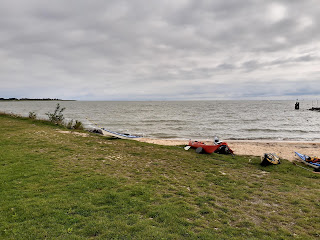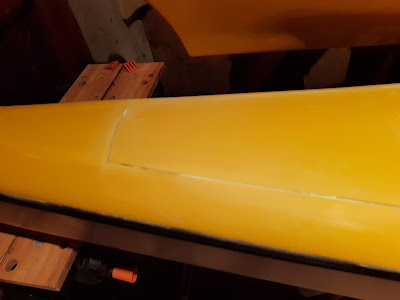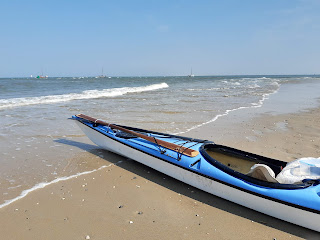Last sunday me and Leen went for a kayak sailing trip. Leen has a Flat Earth sail and both of us are the only members with sails at our kayak club. The wind was a promising 5 to 6 Bft.
Before the trip I fastened the stays as these proved to be too loose on my last sailing trip, already some months ago. We started with a beam wind. Unfortunately when the wind began to push hard my mast collapsed again to leeside. Well, the circumstances were quite nice to paddle so I stored the sail on deck and enjoyed the waves that were surprisingly high due to the Northern wind.
Leen however was still sailing. His sail was pushed almost flat but it didn't collapse. However, I could keep up with him so the sail didn't add much for speed.
After a while I decided to do a new attempt: I hoisted the sail again and pulled the forestay with all my force... too much as the mast collapsed to the front. This became an awkward situation as I wasn't able to retrieve the sail on deck. The only way to do this was to remove the backstays or to push the mast back again with some force. The mast with sail, partly submerged, acted as a skeg causing the Skarabee to put the bow in the wind. Well, that's safe of course but not the direction I wanted to go. I asked Leen for help and he was able to get the sail out of the water. He had to store his own sail to be able to come near me and after that he didn't want to take the risk to hoist his sail again. So we paddled to isle Schelp. There I fastened the backstays even stronger to prevent this would happen again.
We don't often have strong Northern winds and I was anxious to check the waves near isle Hooft. So I headed in that direction and Leen returned home, trying to sail some more. As I was alone now I didn't want to take the risk to sail anymore with the strong wind. So the rest of the trip was only by paddle.
I was now heading partly and fully into the wind and it took some time to arrive at the shelter of Marina Muiderzand which kept me out of the wind for a short break. I checked the weather for lightning but it was okay. So I started the crossing to isle Hooft. This resulted in a sort of 'traving' course: the Skarabee was pushed sideways a lot and it wouldn't weathercock further than 45 degrees into the wind. When the wind diminshed I could point it a little higher but with some strong gusts the bow was swept back again. The waves were high, higher than I have seen here before. Well, here we see the limitations of the Skarabee when paddled empty, too much windage and with a low speed the boat is not weathercocking enough anymore. For now it wasn't a problem as the course brought me directly to the isle Hooft so I didn't fight the Skarabee to get more into the wind. But this could be a possible hazardous situation.
I wanted to paddle around the isle Hooft in a clockwise direction. After leaving the shelter I was almost hitting the rocks on the north side because of the windage when turning the Skarabee to the right. I should have taken a wider turn. But soon I was riding the big waves. Some nice surfs but still the Skarabee wasn't eager to surf. Here I missed the Shadow...
I let myself blown homewards. Unfortunately I had to paddle the last leg partly against the wind but the wind seemed to be decreased a bit. I felt never unsafe in the Skarabee and had no problems in dealing with the sail in this kind of waves.
 |
the route
|



















































